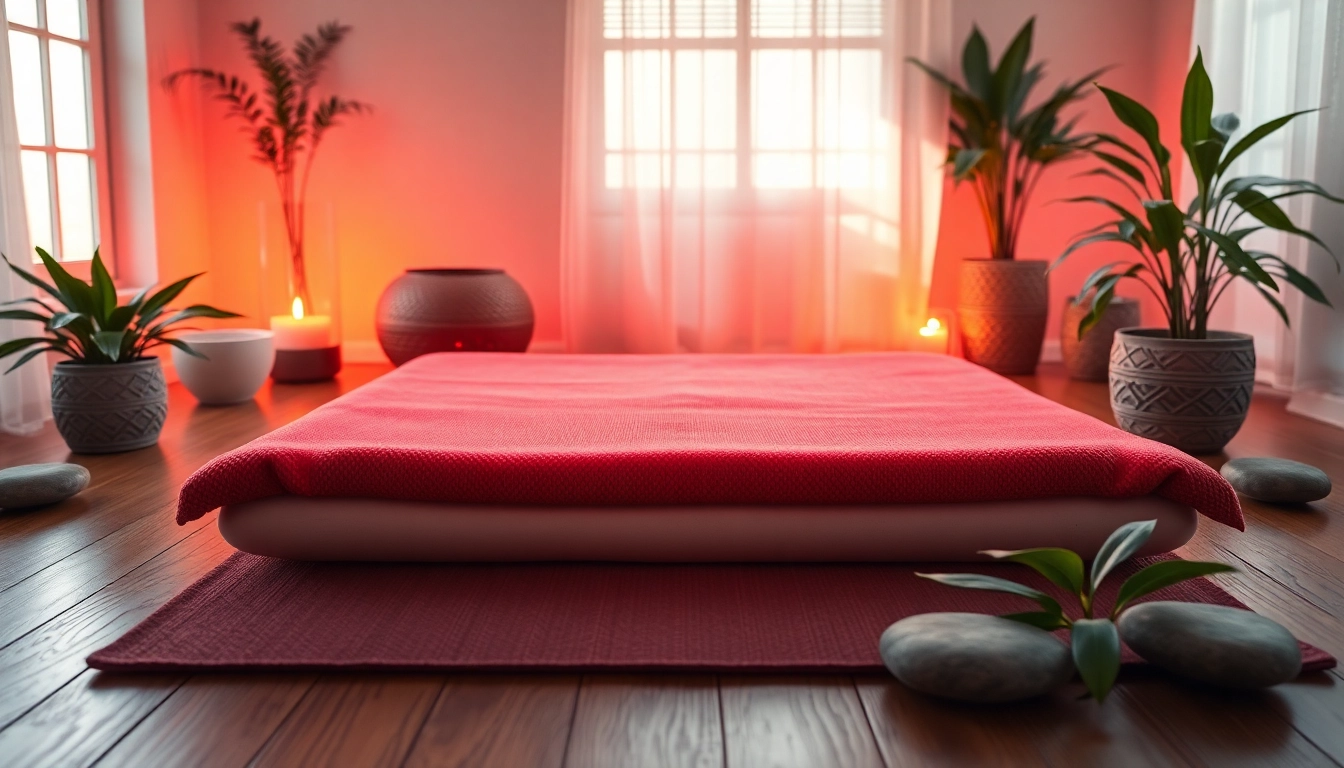Understanding the Basics of Red Light Therapy Mat
What is a red light therapy mat?
A red light therapy mat is an innovative device designed to deliver low-level wavelengths of red light and near-infrared light to the body through a convenient mat format. This type of therapy harnesses light’s natural energy, which penetrates the skin to promote various health benefits. Unlike traditional lighting, the wavelengths emitted by a red light therapy mat are specifically chosen for their therapeutic properties, enabling users to reap the advantages without the need for invasive procedures or medications. Users can lay on the mat or use it as part of their relaxation or wellness routines, making it an accessible option for those looking to improve their health from the comfort of their home or treatment facility. For more insights on how these mats can enhance your well-being, explore this red light therapy mat.
How does red light therapy work?
Red light therapy operates on the principle of photobiomodulation, which refers to the process by which light energy is absorbed by the body’s cells, triggering biological processes that facilitate healing and regeneration. When the red and near-infrared light penetrates the skin, it stimulates the mitochondria, often referred to as the powerhouse of the cell, producing more adenosine triphosphate (ATP). This increased ATP production enhances cellular metabolism and function, encouraging the body to heal itself, limiting inflammation, and supporting tissue repair.
Key features to look for in a red light therapy mat
When selecting a red light therapy mat, it’s essential to consider several features that can influence its effectiveness. Key factors include:
- Wavelength Range: Effective mats typically emit light in the wavelengths of 600-650 nm for red light and 800-850 nm for near-infrared light. Each wavelength penetrates different tissue depths, maximizing the therapeutic effect.
- Intensity and Power Density: The irradiance, or power output, of a red light therapy mat, measured in milliwatts per square centimeter (mW/cm²), should be sufficient to deliver effective results without causing discomfort. A higher irradiance means shorter treatment times and potentially more profound therapeutic benefits.
- Pulse Features: Some mats have the option for pulsing, which alternates the light output. This feature may enhance tissue absorption and can sometimes yield better results.
- Safety Certifications: Make sure the product adheres to safety guidelines and regulations, indicating it is safe for home use.
- Size and Flexibility: Consider the dimensions of the mat and how it fits into your lifestyle. Larger mats cover more area, but portability may be a concern.
- User-Friendly Interface: Look for mats with adjustable settings, timers, and easy operation to enhance user experience.
Health Benefits Associated with Using a Red Light Therapy Mat
Reducing inflammation and pain
One of the most well-documented benefits of red light therapy is its ability to reduce inflammation and alleviate pain. Various studies suggest that exposure to red light can modulate inflammatory processes in the body. It enhances circulation, delivering oxygen and nutrients to injured tissues while helping remove metabolic waste. Through its action, the therapy can be particularly beneficial for conditions like arthritis, back pain, and muscle soreness. Users may find that consistent use of a red light therapy mat provides relief and promotes faster recovery from injuries or chronic pain conditions.
Enhancing skin care and healing
Red light therapy is recognized in dermatology for its effective use in promoting skin health. The treatment encourages collagen production, which is crucial for reducing wrinkles, fine lines, and skin texture irregularities. Furthermore, it assists in healing acne scars, minimizing the appearance of blemishes, and enhancing overall skin tone. Users may notice improvements in skin clarity and elasticity after regular sessions on a red light therapy mat, providing a natural alternative to cosmetic interventions.
Boosting muscle recovery and performance
Athletes and fitness enthusiasts find red light therapy mats particularly valuable for muscle recovery. By reducing muscle soreness and inflammation post-exercise, the therapy allows for quicker recovery times and enhances performance. Studies have shown that using red light therapy before or after workouts can lead to increased endurance and decreased fatigue. With consistent use, individuals may see dramatic improvements in their overall fitness, leading to heightened performance levels in various physical activities.
Choosing the Right Red Light Therapy Mat
Factors to consider for effectiveness
To ensure you choose an effective red light therapy mat, consider the factors impacting its clinical efficacy. Look for products that clarify their light output specifications and provide sufficient power for the intended therapeutic uses. It’s also worthwhile to research user feedback and effectiveness, as real experiences in different applications can provide insights into the mat’s capabilities.
Importance of wavelength and intensity
The wavelength and intensity of the emitted light are critical in determining the effectiveness of a red light therapy mat. Wavelengths between 600 nm and 850 nm can penetrate different tissue depths and provide varied benefits. For maximum results, choose a mat that offers both red and near-infrared light, ensuring a comprehensive therapy experience. Additionally, a mat’s intensity should be powerful enough to deliver an effective dose while being safe for repeated use.
Safety certifications and user reviews
Safety certifications help assure users that a device has undergone rigorous testing before reaching the market. Look for certifications from recognized standards organizations to ensure that the red light therapy mat adheres to safety regulations. Furthermore, reading user reviews provides insights into others’ actual experiences with the product, offering them greater confidence in their choice.
How to Use a Red Light Therapy Mat Effectively
Best practices for usage
To achieve the best results from your red light therapy mat, adhere to several best practices. Begin by ensuring that your mat is used in a consistent routine. Establish a dedicated space for your sessions to enhance your commitment to the practice. It is also essential to remove clothing from the area you wish to treat, as skin exposure allows for maximum absorption of the therapeutic light.
Duration and frequency of sessions
Optimal duration and frequency can vary based on individual needs and the mat’s specifications. Generally, short sessions of about 10 to 20 minutes are recommended for best results, with use two to three times weekly as a good starting point. Depending on your goals—such as pain relief, muscle recovery, or skin treatment—you may adjust the frequency to fit your requirements for efficacy.
Integration into wellness routines
Integrating a red light therapy mat into your wellness routine can amplify its benefits. Consider combining the therapy with other practices like meditation, yoga, or deep breathing exercises to enhance relaxation and healing. Utilizing the mat post-exercise or after a long day can help soothe sore muscles and promote recovery, thereby supporting your overall wellness journey.
Common Myths and Misconceptions about Red Light Therapy Mats
Debunking myths: It’s not just for beauty
Many misconceptions surrounding red light therapy mats stem from the association of red light therapy exclusively with cosmetic improvements. However, it is crucial to recognize that while skin health is a significant benefit, its therapeutic applications extend far beyond beauty. Red light therapy has demonstrated effectiveness in managing pain, inflammation, and muscle recovery, offering a broad spectrum of wellness benefits.
Understanding the science behind the therapy
Despite its growing popularity, some individuals may be skeptical about the science supporting red light therapy. Numerous clinical studies have validated its efficacy, illustrating the biological processes triggered by light exposure at specific wavelengths. By understanding the underlying mechanisms, users can appreciate the science-based benefits derived from incorporating a red light therapy mat into their health regimen.
Clarifying results: What to expect
Users often have varied expectations regarding the outcomes of red light therapy. While many may wish for immediate results, benefits can take time to manifest, especially if the therapy is addressing chronic issues. Patience and consistent use are key; users should note that improvements can accumulate over several weeks or months. By adopting a realistic perspective on their anticipated results, individuals can cultivate a positive experience throughout their therapeutic journey.



